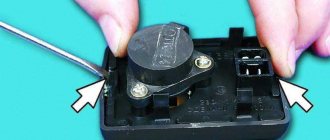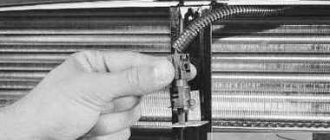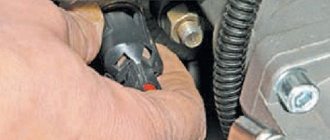From the article you will learn what the main symptom of a malfunctioning mass air flow sensor is. But before even visual diagnostics, you need to talk a little about what this device is, what its operating principle is, but the most important thing is to pay attention to maintenance and repair.
The mass air flow sensor is necessary for the correct operation of the electronic control unit. Such systems are used only in injection engines. In other words, these are the majority of domestic cars that were produced after 2000.
Basic information about the mass air flow sensor
It is called MAF for short. It is with its help that all air that enters the throttle valve for mixture formation is measured. It sends its signal directly to the electronic control unit. This mass air flow sensor (signs of malfunction, Priora or another model are the same) is mounted directly next to the air filter. Or more precisely, between it and the throttle assembly. The design of this device is so “delicate” that it is necessary to measure only thoroughly purified air.
And now a little about how this sensor functions. The internal combustion engine cycles in such a way that during one power stroke it becomes necessary to supply gasoline and air to the combustion chamber of each cylinder in a strict proportion - 1 to 14. If this proportion changes, there will be a significant loss of internal combustion engine power or a significant excessive consumption of gasoline. Only if you adhere to this proportion will the engine function in ideal mode.
Sensor functions
And it is with the help of the mass air flow sensor that all the air that enters the fuel rail is measured. It first calculates the total amount of air, then this information is digitally sent to the electronic control unit. The latter, based on these data, calculates the amount of gasoline that must be supplied for proper mixture formation. And it does this in the right proportion. At the same time, the mass air flow sensor responds to changes in engine operating mode literally instantly. And a sign of a malfunctioning mass air flow sensor is a longer response to pressing the accelerator pedal.
For example, you start pressing the accelerator pedal harder. At this moment, the flow of air into the fuel rail increases. The mass air flow sensor notices this change and sends a command to the electronic control unit. The latter, analyzing incoming data by comparing it with the fuel map, selects a normal amount of gasoline. Another case is if you are moving uniformly, that is, without acceleration or braking. Then very little air is consumed. Consequently, gasoline will also be supplied in small quantities.
Air flow meter. Life and specifics.
- For owners of E-gas, that is, an electronic gas pedal. You can skip this article, since in your case, a German air flow meter was installed from the factory. I have never met anyone else. Moreover, German, precisely by birth, and not just by the name of the manufacturer. The difference will be explained below. Information for further operation; for your engines you also do not need to look for TPS and IAC sensors, they are not provided for by your design.
- For now, I will combine cars with a mechanical throttle into one block. This is where the fun begins. It's no secret that economic globalization is taking place around the world and even famous companies produce their goods in different factories. In some cases this does not lead to anything good. Now closer to the body, as Henri-René-Albert-Guy de Maupassant (that’s his full name) used to say. Air flow meters are manufactured in Germany and Russia and have the same catalog numbers, and differ only in two inscriptions “made in Russia” and “made in Germany”. Everything would be fun if it weren't so sad. The data they provide to the ADC differs from each other from the point of view of the ECU (ECU - electronic control unit). The most successful comparison: a German measures the incoming air plus or minus a thimble, a Russian plus or minus a bucket. Naturally, this most directly affects the operation of the engine. In factory configurations, I sometimes managed to see “Germans”, but in 90% of cases there were Russian flow meters.
Now for the difference between the Niva mass air flow sensor and mechanical throttles. They differ in the type of ECU. Bosch 7.0 is equipped with a flow meter 0280218037, mainly for cars before 2008. For all ECUs of the new type, the flow meter is 0280218116. I usually keep only the new type flow meter in stock; the old type is supplied upon request. There was a long discussion on the diagnostics forum regarding the interchangeability of these numbers. We came to the conclusion that they are NOT interchangeable. Therefore, be careful, several more numbers were produced for front-wheel drive, and our sellers just wanted to get in on it. And the car will drive, and the engine will work, but not as it should.
Processes during engine operation
And now a little more about how all these processes occur in an internal combustion engine. Elementary physics largely influences the work here. For example, when you press the accelerator pedal, the valve in the throttle assembly sharply opens. The more it opens, the more air begins to be sucked into the fuel supply system.
Consequently, when you press the gas pedal, the load increases, and when you release it, the load decreases. We can say that the DMRV monitors these changes. It is worth noting that the main symptom of a malfunction of the mass air flow sensor is a decrease in the dynamic properties of the car.
Moneybox of knowledge
Today, atmospheric gasoline engines operate according to two main schemes. These are DMRV (filament and filament) and DBP (absolute pressure sensor). Flow meters provide data to the ECU about the air passing through them, DBP shows the vacuum in the intake manifold. The second scheme is more modern and more reliable, but it also has its drawbacks. To switch to working “by pressure”, you need to install other sensors, redo the mathematical model of data processing and generally strain yourself, but AvtoTAZ does not like to do this. Therefore, since the appearance of injectors at the factory, the engine body kit has not changed. Since the beginning of the production and installation of injectors on the Niva, the Niva mass air flow sensor has undergone three reincarnations in terms of article numbers, but not a single one in essence.
Design Features
This is one of the most expensive sensors in the internal combustion engine control system. The reason for this is that it contains an expensive metal, namely platinum. The basis of the sensor is a plastic tube of a strictly defined diameter. It is located between the filter and the throttle assembly. Inside the case there is a thin wire made of platinum. Its diameter is about 70 micrometers.
Of course, it is very difficult to measure the passing air. In an internal combustion engine control system, air flow measurement is based on temperature measurement. The platinum wire is subjected to sudden heating. By how much its temperature drops in comparison with the set one, the amount of air passing through the sensor body is determined. Pay attention to the sign of a bad mass air flow sensor to know if it is OK.
Oxygen
The Chevrolet Niva oxygen sensor is also called a lambda probe; it is located in the exhaust gas system on the receiving pipe. The oxygen contained in the exhaust gas interacts with it, thereby creating a potential difference at the outlet. It varies from approximately 0.1 to 0.9 V. For it to function normally, its temperature must be at least 360 degrees. For these purposes there is a built-in heating element. If the potential difference at the output is low, then the mixture begins to enrich, and if, on the contrary, it is high, then the mixture becomes depleted.
Device maintenance
During operation of an engine with an electronic control system, the sensor still becomes dirty. To clean it, there is a special algorithm embedded in the control system. It allows you to heat a platinum wire in literally one second to a temperature of about a thousand degrees. If there was any dirt on the surface of this wire, it immediately burns without a trace. This is how to clean the mass air flow sensor. The signs of a malfunction, whether it is a Kalina or any other car, will be the same.
This procedure is performed every time you turn off the engine. The mass air flow sensor is very simple in design, and its operational reliability is high. However, it is not recommended to repair this unit yourself. If a breakdown occurs, the best option is to contact competent diagnosticians and mechanics.
Disadvantages of the node
Please note that if the sensor fails, it is most effective to replace it with a new one. It cannot be repaired, which is its main drawback, since the price of a new one is sometimes more than two thousand rubles. But there is another minor drawback, which lies in the principle of operation. Any mass air flow sensor has this drawback. Signs of a malfunction (diesel or gasoline in the power system) are discussed in the article.
It allows you to measure the volume of air that entered the throttle assembly. But for engine operation it is important to know not the volume, but the mass. Of course, to perform the conversion you will also need to know the air density. It is for this purpose that a measuring device is installed in the air intake, in close proximity to the sensor, which measures the temperature.
How to increase service life
Try to change the air filter on time, since the mass air flow sensor will not be able to work for a long time if dirty air passes through it. The thread and the entire internal surface can be washed using special sprays for carburetors. Just try to do everything carefully and avoid touching the spirals. Otherwise, you will end up with an expensive replacement of the air flow sensor. In recent years, other designs are often used instead of such a sensor. This type of mass air flow sensor is used on some foreign cars. Symptoms of a Nissan malfunction are similar to those that occur on “tens” or “Prior”.
A pressure sensor is often installed to monitor the flow of air into the combustion chambers. To increase the service life of the mass air flow sensor, it is necessary to promptly replace the air filter, and also pay attention to the cylinder-piston group. In particular, excessive wear on the piston rings will cause the platinum wire to become coated with oil deposits. This will gradually lead to damage to the sensor.
Major breakdowns
You should know how to identify a faulty mass air flow sensor. The internal combustion engine constantly changes its operating mode. Depending on the speed and load, a different air-fuel mixture is required. To mix it properly, you need a mass air flow sensor. It is also called a flow meter.
As you already know, it allows you to determine and adjust the mass of air that enters the fuel rail of the injection system. If your mass air flow sensor is working in ideal mode, then this is a guarantee that the engine will function normally. Please note that such a device cannot be repaired, even if you have many tools and accessories.
Fuel level
The Niva Chevrolet fuel level sensor determines the remaining fuel in the tank and transmits the readings to the dashboard. It is located in the fuel tank. Its breakdown can lead to the car stopping at the most inopportune moment, so the driver will not know how much fuel is actually in the tank. Therefore, if there are problems with it, it is better to replace it as soon as possible, this can be done like this:
- The right side of the rear seat rises
- A fluffy rag is folded back
- Unscrew two screws on the fuel pump hatch
- Removing the hatch
- Disconnect the two pipes and terminals
- Unscrew 8 screws
- Carefully remove the fuel pump and replace the required element
All work is done within 10 minutes.
Symptoms of malfunctions
And now a little about what symptoms occur when the sensor breaks down. Often, when this element fails, the engine begins to idle intermittently, its speed constantly fluctuating. When accelerating, the car begins to “think” for a long time, there is no dynamics at all. Often the crankshaft speed also decreases or increases at idle. And if you are lucky enough to turn off the engine, then starting it turns out to be very difficult, and sometimes even impossible. This means that the mass air flow sensor needs to be replaced. “Priora”, the faults of which are scanned by the ECU, will definitely give an engine error.
Please note that it is not necessarily the sensor itself that has failed. It is not uncommon to observe small cracks or cuts in the corrugation that connects the sensor to the throttle valve. If you suddenly see that the Check Engine light starts to light on the dashboard, and the above symptoms are also present, then you can say that the flow sensor has become unusable. But you shouldn't rely on this alone. It is advisable to conduct a complete engine diagnostics. It is worth noting that the symptoms of a malfunction of the mass air flow sensor are very similar to those that appear when the TPS breaks down, for example.
The main signs of a malfunction of the mass air flow sensor are loss of engine power, difficult starting, “floating” engine speed. To find out the exact cause of the flow meter failure, you need to visually inspect the device and then test it with a scanner (via Openidag), a voltmeter or a motor tester.
Speeds
The Chevrolet Niva speed sensor helps to determine exactly how fast the car is moving. The received information is transmitted to the speedometer. In addition to this, it also performs such functions as:
- Controls fuel consumption
- Displays information on the dashboard
- In cars with automatic transmission, it is part of the system that is responsible for engine control.
If for some reason it fails, then further movement becomes difficult. The causes of failure may be contamination or oxidation. If the device stops working, first of all you need to check for the following problems:
- Contacts have oxidized
- There was a break in the electrical wiring
- Wire insulation is damaged
- There are mechanical damages
Diagnostics can be done both visually and using a multimeter. To do this, the sensor is removed, after which you need to connect the plus to the contacts, and the minus to the ground of the car. We switch the multimeter to power measurement mode and if it shows that the voltage has increased, then the element can be considered faulty.
To change it you need to disconnect the battery. When the car is de-energized, we find the sensor which is located on the rear cover of the transfer case. Disconnect the terminal from it and unscrew it with a wrench.
The Niva Chevrolet phase sensor operates on the Hall effect principle. It works as follows: there is a special pin on the camshaft and when it runs parallel to the end of the sensor, the sensor begins to transmit a voltage pulse to the existing controller, which should have the same position as the piston of the first cylinder in the compression position. That is, it is needed so that fuel injection and the order of operation of the engine’s cylinders correspond to each other.
In the event of a failure, it or its chain controller writes a special code into its memory and activates the alarm. And to remove it you need:
- Disconnect the battery
- Remove the decorative casing from the engine
- Disconnect the connector from the sensor
- We unscrew the bolt that secures it to the cylinder block.
- We remove the part from its seat
- Install the new one in reverse order
What does a faulty air flow sensor cause?
Operating an engine with an inoperative/faulty flow meter causes detonation of the fuel mixture in the combustion chamber. This affects the operation of the crank mechanism (crank mechanism) and destroys the piston surface, which can cause a “wedge” in the engine.
What indications should a working mass air flow sensor give?
The voltage of the analog-to-digital converter (ADC) of the flow meter when the engine is not running should be 0.996 V. Indicators of 1.016 and 1.025 V are acceptable, but if they reach more than 1.035 volts, it means that the sensing element of the mass air flow sensor is clogged.
To accurately determine the degree of deviation of the operating flow meter values from normal values, it is necessary to evaluate the engine operation at different speeds.
For example, for an injection 1.5-liter VAZ 2111 engine, if it is in good condition, at idle (860–920 rpm) the correct readings are 9.5–10 kg/hour, and at 2 thousand rpm - 19 –21 kg/hour. If the flow meter at 2 thousand rpm shows about 17–18 kg, then the car will drive stably. If the values are from 22 to 24 kg/hour, then the vehicle will move steadily, but the fuel consumption per 100 km will be approximately 10–11 liters. In addition, the car will have difficulty starting in cold weather due to fuel overflow when the engine warms up.
Recommendations
Comments 57
The phase sensor can be checked by B_K or at the diagnostics))) Or you can buy a new one for 350 rubles and replace it. In general, if it needs to be changed for a long time)
These spark plugs are already outdated in production and quality; install Bosch Platinum, you won’t regret it. Look at the phase sensor!
Oh, and I forgot, find BOSCH Platinum spark plugs, they cost 125 rubles apiece, but they are worth the money, not NLC, not Denso, not Brisk, and they’re not even close)))) The car really drives differently. Check the wires high just strain in a dark garage or with your hands, or if you change oak ones, change them to factory ones! Silicone shit.
I changed the wires and installed them well. Spark plugs d17vr or something like that are called... Russian
Spark plugs 17DVR seem to have a gap of 0.7 mm for carburetor internal combustion engines, but for injection engines they need 1-1.1 mm. Quote from one site: Let's just give an example: a spark plug gap that has floated by 0.2 mm on a 4-cylinder, 4-stroke, 2-liter, 8-valve engine of a well-known brand provokes a loss of power in the engine and an increase in fuel consumption by about 4%. A further increase in distance can lead to engine malfunctions, even greater loss of power and, accordingly, increased fuel consumption.
Tomorrow I'll go order a Bosch, thanks, I didn't know. The diagnostician advised me that they cannot be faked...
It seems to me that everything is faked now. Bosch pumps generally flew this summer, but the cheapest ones go on and on
I changed the wires and installed them well. Spark plugs d17vr or something like that are called... Russian
In any case, put these candles in the firebox and use normal ones.
1) Spark plugs 2) Armor-Wires 3) Camshaft sensor How to check the MAF sensor, start the car, remove the connector from the sensor, if the car really drives faster then it’s screwed). 12 to 16 liters in the summer. Also check the compression and valves. My advice is to start small. Good luck!))
I drove faster and more fun... but how can I check the camshaft sensor?
The voltage should be about 1V, preferably lower. Ideal 0.996-0.998V. If it is higher than 1B, then the air flow sensor is slowly starting to die. And you can check its effect on consumption by simply turning it off and driving without it. The check will heat up, and the ECU will prepare the mixture according to DTOZH, TPS, etc., i.e. without mass air flow sensor. So you'll see what the cost will be.
Got it, I'll ride without it
The voltage should be about 1V, preferably lower. Ideal 0.996-0.998V. If it is higher than 1B, then the air flow sensor is slowly starting to die. And you can check its effect on consumption by simply turning it off and driving without it. The check will heat up, and the ECU will prepare the mixture according to DTOZH, TPS, etc., i.e. without mass air flow sensor. So you'll see what the cost will be.
It showed 1.011 for me. How is that? They said it was normal.
I turned off the mass air flow sensor. I drove faster. Idle 840. It seems like it wasn’t there at all. Only the check light is on.
It showed 1.011 for me. How is that? They said it was normal.
This is a good indicator, but it is not always possible to judge by it. I came across a couple of cars in which the figure was 0.996 and 1.023, respectively, and the air consumption was 13-14 kg (about front-wheel drive). By replacing the sensor with a new ADC, it became 0.996 and the air flow fell by 9 kg/hour (I didn’t understand what was causing this, but replacing the sensor helped). I personally checked the ADC of the sensor; it is allowed up to 1.05 - there are no noticeable changes. but when the indicator falls beyond 1.05, the gasoline consumption begins. Of the last ten mass air flow sensors sold (we're talking about BOSCH 116), on four only the ADC was ideal 0.996, on the rest 1.01-1.02 (these are the spare parts now, gentlemen). You also need to look at the air consumption at 3000 rpm, sometimes at XX everything is OK, but at 3000 rpm it stops, hence the lack of traction and fuel consumption. Also check the pressure of the pump, maybe it presses 2-2.2 atm, there will be an overrun. It’s better to get to a normal diagnostician, it will be faster and your nerves will be fine.
Symptoms of a problem
The mass air flow sensor is located in the air duct near the air filter. It is designed to determine the amount of incoming air. Depending on its readings, the control unit will show how much fuel is needed to form a high-quality fuel mixture. The normal ratio is 1:14. Therefore, the quality of the fuel-air mixture depends on the correct readings of the flow meter.
The high-quality operation of the mass air flow sensor depends largely on the cleanliness of the air filter. Therefore, if symptoms of a malfunction of the mass air flow sensor appear, you should first check the air filter before making repairs. The flow meter is usually beyond repair. If it is faulty, it is replaced with a new device. But its cost is quite high, so you should first make sure that the causes of the problems are in the sensor and not in other malfunctions of the machine.
The signal for diagnosis is the following symptoms of a malfunction of the mass air flow sensor:
- Check Engine appears on the instrument panel;
- an error is displayed indicating a low level of the mass air flow sensor signal;
- the engine is bad, accelerates very slowly, stalls, its power drops;
- high level of fuel consumption;
- the engine is unstable at idle;
- the engine stalls when changing gears;
- The rpms are either high or low.
There are other symptoms of a “dying” sensor. For example, it may have cracks in the corrugated hose that connects the throttle body to the sensor. If the engine stalls, there may be a power problem or damaged wiring. This is a signal to check the electrical wiring. If malfunctions are detected, the machine's electrical system must be repaired.
In addition to the above possible signs of failure of the mass air flow sensor, you should diagnose the sensor signal level.
A low signal level may mean the following:
- Mass air flow sensor is not connected;
Disconnected sensor connector
- open circuit in the sensor connection circuit;
- the mass in the chain breaks, oxidation appears;
- signal wires are broken or incorrectly connected;
- Engine control unit malfunction.
You should not draw conclusions about a malfunction of the mass air flow sensor, relying only on the symptoms listed above. A complete diagnosis of the engine and machine should be carried out, since signs of a flow meter failure may appear if other devices malfunction (for example, due to a clogged air filter). Then you need to repair these devices to restore the car's functionality.
Part diagnostics
Serviceability is determined with a multimeter in voltmeter mode. The results of the check are interpreted as follows:
- The sensor is working: 1–1.02 V.
- OK, cleaning required: 1.03 V.
- average wear, readings are incorrect: 1.04 V.
- high wear, urgent replacement needed: 1.05 V.
- the part is faulty: 1.06 V. The engine operates in emergency mode, relying on the readings of the throttle assembly.
After cleaning, you need to check the flow meter again; the indicator should be at 1.02 V. If the mass air flow sensor breaks down, it cannot be repaired. If the flow meter fails, it will have to be replaced with a new part.
The vast majority of foreign cars with injection engines after 2000 began to be equipped not with mass air flow sensors, but with pressure controllers.
Checking and repairing at home
There are eight ways to independently check amplitude and frequency mass flow sensors.
Method No. 1 - disabling the air flow meter
The method consists of disconnecting the sensor from the fuel system of the car and checking the functionality of the system without it. To do this, you need to disconnect the device from the connector and start the engine. Without a mass air flow sensor, the controller receives a signal to switch to emergency operation mode. It prepares the air-fuel mixture only based on the throttle position. If the car moves faster and does not stall, it means that the device is faulty and requires repair or replacement.
Method No. 2 - flashing the electronic control unit
If the standard firmware has been changed, then it is unknown what reaction of the controller is programmed in it in case of an emergency. In this case, you should try to insert a 1mm thick plate under the throttle stop. The turnover should increase. Now you need to pull out the chip from the air flow meter. If the power unit continues to work, then the cause of the malfunction is the firmware.
Method No. 3 - installing a working sensor
Install a known good part and start the engine. If after replacement it begins to work better, the motor does not stall, then replacement or repair of the device is required.
Method No. 4 - visual inspection
To do this, use a Phillips screwdriver to unscrew the clamp holding the air collector corrugation. Then you need to disconnect the corrugation and inspect the internal surfaces of the air collector corrugation and the sensor.
Inspection of duct corrugation
There should be no traces of oil or condensation on them, the surfaces should be dry and clean. If you do not take care of the air filter and change it rarely, then dirt can get on the sensitive element of the sensor and cause it to break. This is the most common malfunction. Traces of oil may appear in the flow meter if the oil level in the crankcase is high, or if the oil sump of the crankcase ventilation system is clogged. If necessary, you need to clean the surfaces using special cleaning products.
Method No. 5 - checking the mass air flow sensor with a multimeter
To do this, you need to turn on the tester in a mode in which constant voltage is checked. The limit value for measurements should be set to 2V.
DMRV operation diagram
- The yellow wire is located closer to the windshield. It serves as an input for a signal from the flow meter.
- The white-gray wire is the sensor voltage output.
- The black and pink wire leads to the main relay.
- The green wire is used to ground the sensors, that is, it goes to ground.
The wires may have different colors, but their location is unchanged. To check, you need to turn on the ignition, but do not start the car. The red probe from the multimeter must be connected to the yellow wire, and the black one must be connected to ground, that is, to the green wire. We measure the voltage between these two outputs. Multimeter probes make it possible to connect without disturbing the insulation of the wires.
On the new device, the output voltage ranges from 0.996 to 1.01 V.
During operation, this voltage gradually increases and by its value one can judge the wear of the flow meter:
ADC flow meter readings
Diagnostics of the mass air flow sensor "Tseshkoy" is not difficult and can be done with your own hands.
If there is dirt on the removed sensor, you can clean it yourself. You can use WD-40 to wash it. To clean the mass air flow sensor, you must first remove the pipe from it, and then dismantle the device itself. Inside the device there is a mesh and several wires - sensors.
They need to be sprayed with cleaning agent and washed. Then let the liquid dry. If dirt remains, the procedure should be repeated. You need to clean the pipe with the same product. It must be free of dirt and oil stains. After replacing the air filter, all parts must be returned to their place. After the cleaning procedure, the functionality of the device can be restored to 80%, the error about the reduced sensor signal level disappears (the author of the video is “24 hours”).
Flushing the sensor will help avoid costly repairs.
Method number 6 - checking with a scanner
- Install a diagnostic program on your phone (smartphone), tablet or laptop computer (for example, Torque Pro, Opendiag, BMWhat, OBD Auto Doctor).
- Connect your mobile device or laptop to the diagnostic connector located on the vehicle's electronic control unit using a special cable, Bluetooth channel.
- Launch the diagnostic utility on your phone (smartphone) or computer.
- Wait until the program finishes scanning all vehicle components. As a result, the utility will check the serviceability of each vehicle unit.
- Decipher the error codes that the program will show after the diagnostics are completed.
To perform this method, testers are used:
Method No. 7 - checking by Vasya the Diagnosticist
To identify a malfunction of the mass air flow sensor without removing it from the car, you need to:
- Install a program called “VASYA diagnostician” on your laptop (laptop) and run it.
- Connect the adapter to the vehicle's diagnostic port.
- Select the item “Electronics 1” or “01 – Engine electronics” from the “Control unit” tabs to connect to the vehicle’s control unit.
- Go to “Custom Groups”.
- Select 211, 212 (passport value) and 213 (current value).
- Compare current indicators with passport data. If the deviations are high, then it is necessary to replace the mass air flow sensor.
Method No. 8 - using a motor tester
This method is used to test frequency-type flowmeters.
To check the mass air flow sensor with a motor tester (oscilloscope), you need to connect it to the sensor (depending on the car brand) and start the engine.
Tools:
Niva Chevrolet speed sensor
There may be several sensors in a car. Main symptoms of malfunction Sooner or later, this element becomes unusable. The design of any camshaft position sensor is extremely simple: To find it, you need to look in the vehicle operating book. Some vehicles have multiple Hall sensors.
VAZ replacement of phase sensor, symptoms of malfunction.
You can also often hear another name for it: Signs of malfunction The electronic engine control unit monitors sensor readings. It is difficult to independently detect a breakdown in an electronic device, but there are several signs that indicate the sensor is not working properly or is broken. A sharp increase in fuel consumption is a sign of a malfunction of the camshaft position sensor. The first sign is a sharp increase in fuel consumption.
Every driver knows how much gasoline or diesel fuel his car consumes per kilometers driven. Look at the multimeter display.
Check the indicator with the specification specified in the car repair manual. In most cases you will see a fluctuating signal between 0.3 and 1 volt. To do this, set the multimeter to “constant current” mode. Connect the other wire of the multimeter to the power wire of the sensor.
Compare the multimeter readings with the specifications specified in the machine's repair manual. Compare the multimeter readings to the specifications found in your vehicle's repair manual. If the reading on the multimeter is lower than indicated in the repair manual or the data is completely missing, then most likely the camshaft sensor has failed.
If, after self-diagnosis of the camshaft position sensor, you determine that it is fully operational, then there may be a breakdown or malfunction in the vehicle components associated with the sensor. This allows you to accurately inject fuel, form an air-fuel mixture and ignite it at the required moment when starting the engine.
But it happens that devices for some reason begin to act up.
But the fact that the sensor has failed or is starting to fail can be determined independently by certain signs. One of them is a sudden increase in fuel consumption.
That is, you are already accustomed to the fact that your car consumes a certain amount of fuel per hundred kilometers in certain city or highway modes.
And if the flow rate unexpectedly, for no reason, exceeds the norm, then perhaps the Hall sensor begins to fail.
Expert
The bottom line is that the car had a Bosch 7.9.7+ block, everything ran fine, but I needed to put a January 7.2 block on it
January was installed and flashed with firmware for the Chevrolet Niva.
Everything starts up and rides like a fairy tale.
But the check light comes on Phase sensor error, it doesn’t light up all the time, it just blinked and is still not active. And it lights up only at high speeds, when you turn the engine at 5-6 thousand and it lights up. If you drive without turning the engine, it may not light up for a couple of days.
The camshaft position sensor (hereinafter referred to as CPS) is designed to determine the position of the timing belt in relation to the crankshaft. The data that comes from the DPRV is used by the electronic control unit to adjust the injection frequency and restore the ignition angle.
You can often hear that drivers call DPRV a Hall sensor. Another name is quite acceptable, since the operation of the DPRV is based on the Hall effect. This is where the corresponding name came from.
ATTENTION! A completely simple way to reduce fuel consumption has been found! Don't believe me? An auto mechanic with 15 years of experience also didn’t believe it until he tried it. And now he saves 35,000 rubles a year on gasoline! Read more"
Replacing the air flow sensor
To replace the sensor with your own hands, you need to prepare a shaped screwdriver and a “10” key.
The replacement procedure consists of the following steps:
- First you need to turn off the ignition and open the hood.
- Then you need to disconnect the negative terminal on the battery.
- At the next stage, you need to loosen the clamp with which the corrugation is attached to the mass air flow sensor.
- Next, remove the corrugation from the pipe.
- Then you need to bend the comb and disconnect the sensor connector.
Disconnecting the sensor connector
Thus, if the car stalls and has all the signs of a breakdown of the mass air flow sensor, then before you start repairing it, you should check the level of its signal, it should not be low, perform a full diagnosis of the car and repair all faulty components and parts.
It is important to undergo regular vehicle inspections and perform timely maintenance, then the parts and components will last longer.
Temperature
The Niva Chevrolet temperature sensor helps determine the ambient air temperature. Located on the lower part of the bumper on the driver's side. If it stops working, you can replace it, for this you need:
- Disconnecting the battery
- Find the sensor itself
- Carefully pull it out of its seat
- Let's take him outside
- By pressing the latch, disconnect the plug from it
- Install the new one in reverse order
Video “Checking the mass air flow sensor using a multimeter”
This video from the “Simple Opinion” channel demonstrates how to check the mass air flow sensor with a multimeter.
When the internal combustion engines that modern cars are equipped with operate, a fuel-air mixture is burned, for the formation of which, as you can easily guess from its very name, it is necessary to mix fuel with air, and in strictly defined proportions. Accordingly, the systems that are responsible for the formation of this substance must accurately “know” the consumption of each of its components at every moment of operation of the power unit. The value of this indicator for one of them helps to determine the mass air flow sensor (MAF). It should be noted that it is present in the design of only injection engines, and if drivers notice signs of a malfunction of the mass air flow sensor, then it should be checked and, if necessary, replaced.
Purifier selection options
How to clean the flow meter? The modern market offers many products for cleaning regulators; let’s look at the most effective options:
- Liqui Moly. This manufacturer, as you know, produces not only cleaning products, but also motor and transmission oils, as well as other types of liquids. If you believe the official information provided by the manufacturer, then this product belongs to the high-quality category. Accordingly, the cost of such a MAF cleaner will also be high. In fact, Liqui Moly cleaners cope with their tasks quite effectively - this product perfectly removes dirt from the sensor. If the flow meter was in working order at the time of cleaning, then after that it will work for a long time. The use of Liqui Moly is relevant in both gasoline engines and diesel power units.
- Alternatively, you can use alcohol to clean the device. This method is considered one of the oldest, but nevertheless the most effective. Due to its chemical properties, alcohol is good at removing clogs that accumulate on the sensitive component of the air flow sensor. Despite its effectiveness, today this method is not used so often and is usually used by unscrupulous technicians at service stations. The client pays for a special substance, for example, Liqui Moly, and in fact the cleaning is carried out using alcohol.
- The next option is fluid for carburetor engines. This option is considered one of the most effective and frequently used. Using carburetor fluid, you can effectively clean it, and as practice shows, such a product allows you to remove all contaminants.
- Another product sold in spray form is Liquid Key. This cleaner is used to remove all kinds of contaminants, not only from the flow meter, but also from other mechanisms and components.
- A universal tool for performing many tasks is WD-40. This liquid is used by our compatriots to clean all kinds of components, remove rust, get rid of squeaks, etc. Not so long ago, our car enthusiasts began to use it to clean flow meters (the author of the video is the Gen channel MB W140 Germany).
Why do you need a mass air flow sensor?
What does a mass air flow sensor look like on a car?
The mass air flow sensor is an important sensor located directly behind the engine air filter, or more precisely, just between it and the throttle assembly. It is designed so finely that it allows you to accurately measure the flow rate of only air that is well cleared of mechanical impurities
During operation, the mass air flow sensor transmits signals to the electronic engine control system, which are processed and interpreted as the volume of air that is supplied to form the fuel-air mixture. For normal operation of the power unit, the volumetric ratio of liquid fuel (gasoline, diesel fuel) and air in it should be close to 1x14. If this proportion is violated, then either a significant loss of engine power or excessive fuel consumption occurs (these, by the way, are the main signs of a malfunction of the mass air flow sensor). The information received by the ECU from the sensor that determines the mass air flow helps to avoid this.
The mass air flow sensor measures the amount of air that enters the fuel rail per unit time. It transmits this data to the ECU, which instantly calculates the amount of liquid fuel that needs to be supplied to form the mixture, and gives the appropriate “instructions” to the engine devices responsible for this. Thus, if, for example, you press the accelerator pedal, more air immediately begins to flow, the mass air flow sensor instantly detects this, sends data to the computer, which increases the supply of gasoline or diesel fuel in the appropriate proportion. If the amount of air decreases, then the volume of liquid fuel supply decreases.
From a design point of view, there are three types of such sensors that are actively used:
- Based on pitot tube;
- With hot-wire anemometers;
- With film meters.
Mass air flow sensors built on the basis of a pitot tube are considered obsolete and are not used in the newest engine models. They are so-called vane flowmeters, the main elements of which are plates connected to potentiometers and softly fixed to the axes. Changing their position under the influence of air flow, they act on the potentiometer, which changes its electrical resistance.
Mass air flow sensors with hot-wire type meters are quite expensive, although they are very effective. They are equipped with special heat exchangers consisting of two platinum filaments, which are heated by passing electric current. One of them is blown with a flow of air, the second remains a control one, and based on the difference in the current passing through them, the ECU calculates the amount of air supplied to form the fuel mixture. Mass air flow sensors with film meters are considered the most modern. According to their principle of operation, they are almost similar to hot-wire anemometers, only they do not use platinum threads, but ceramic elements coated with platinum.
Types and design of sensors
The mass air flow sensor is a complex element of an injection engine. It consists of a sensor module and a tube-shaped housing. On imported air flow devices the grille is metal, while on Russian analogues it is plastic. The dimensions of all sensors are identical; there is a screw for adjusting the carbon dioxide level.
The difference between the sensors is that some of them are touch sensors, others are film ones.
Flow meter designs have changed over the years. In recent years, the most popular in the automotive markets has become the following: a sensor based on a heated wire and a flow meter on a vane damper.
The sensitive element located in the pipe consists of 2 thin platinum threads. When the ignition is turned on, electric current is transmitted to these threads. The current exposes the platinum filaments to heat. The air entering through the air intake cools them and changes the resistance. These signals are monitored by the motor control unit, which increases or decreases air flow.
The positive aspect of this type of sensor is that it quickly responds to changes in air flow, measures the mass of air passed through, and does not interfere with its flow.
Main symptoms of a malfunctioning mass air flow sensor
A malfunction of the mass air flow sensor, as noted above, leads to either an over-enrichment or a depletion of the fuel mixture with gasoline or diesel fuel, which negatively affects the functioning of the engine and can lead to serious damage. Most often, malfunctions of the mass air flow sensor are associated with a clogged air filter: the air is poorly cleaned, and the mechanical particles contained in it get into the sensor, which is the cause of its failure. It should be noted that mass air flow sensors are non-repairable devices, and if they fail, they must be replaced with new ones.
Practice shows that the main signs of a malfunction of the mass air flow sensor are as follows:
- A Check Engine error appears, which indicates that the signal level of this sensor is very low;
- The engine consumes more fuel than usual;
- The power unit does not start well, its power decreases, it begins to stall;
- The car accelerates poorly;
- The engine runs either at high or low speed.
Of course, all the signs may also appear during other vehicle malfunctions, but in any case, if at least one of them is detected, this is a good reason to visit a service station. However, you can check the mass air flow sensor for malfunctions yourself, without contacting service station specialists.
Where to buy car accessories
Spare parts and other products for the car are easily available for purchase at auto stores in your city. But there is another option that has recently received significant improvements. You no longer need to wait a long time for a parcel from China: the AliExpress online store now offers the opportunity to ship from transshipment warehouses located in various countries. For example, when ordering, you can specify the “Delivery from the Russian Federation” option.
The Chevrolet Niva has a large number of different sensors that are involved in the operation of the entire car and its engine. Each sensor has its own task and must perform it well, since the operation of the entire car depends on it.
In this article we will talk about the temperature sensor on the Niva Chevrolet car, since there are two of them in this car, we will look at each of them, tell you where it is installed, what functions it is responsible for and describe the signs of its breakdown. After studying the article, you can easily find the answer to any question you have about the temperature sensor on the Niva.











